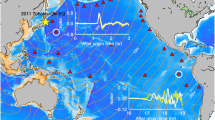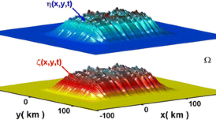Abstract
Based on a simple physical model, we derive a formula for the energy radiated into a tsunami by a dynamic deformation of the ocean floor. We use the analytical solutions developed by J.L. Hammack, Jr. (1972, Tsunamis – A model of their generation and propagation, Ph.D. Dissertation, 261 pp., California Institute of Technology, Pasadena) to show that, in addition to its expected dependence on the source rise time, and even in the limiting case of an instantaneous source, the energy of the tsunami is controlled by the ratio of water depth to source size. For very large earthquakes, these results have no impact on the time-honored approximation which uses the static deformation of the ocean floor as a set of initial conditions of the surface displacements for numerical simulations, but they provide insight into the theoretical limits of this practice.










Similar content being viewed by others
References
Ben-Menahem, A., & Singh, S. J. (1981). Seismic waves and sources. New York: Springer.
Boas, M. (1983) Mathematical methods in the physical sciences, 820 pp., J. Wiley & Sons, New York.
Boatwright, J., & Choy, G. L. (1986). Teleseismic estimates of the energy radiated by shallow earthquakes. Journal of Geophysical Research, 91, 2095–2112.
Dean, R.G., & Dalrymple, R.A. (2000). Water wave mechanics for engineers and scientists, 353 pp., World Scientific, Singapore.
Derakhti, M., Dalrymple, R. A., Okal, E. A., & Synolakis, C. E. (2019). Temporal and topographic source effects in tsunami generation. Journal of Geophysical Research Oceans, 124, 5270–5288.
Dixon, W. J., & Massey, F. J, Jr. (1969). Introduction to statistical analysis (3rd ed.). New York: McGraw-Hill.
Dutykh, D., & Dias, F. (2009). Energy of tsunami waves generated by bottom motion. Proceedings of the Royal Society of London, Series A, 465, 725–744.
Geller, R. J. (1976). Scaling relations for earthquake source parameters and magnitudes. Bulletin of the Seismological Society of America, 66, 1501–1523.
Gill, A.E. (1982) Atmosphere-ocean dynamics, 662 pp., Academic Press, New York.
Hammack, J.L. Jr. (1972). Tsunamis – A model of their generation and propagation, Ph.D. Dissertation, 261 pp., California Institute of Technology, Pasadena.
Iida, K. (1963). A relation of earthquake energy to tsunami energy and the estimation of the vertical displacement in a tsunami source. Journal of Earth Sciences of Nagoya University, 11, 49–67.
Kajiura, K. (1963). The leading wave of a tsunami. Bulletin of the Earthquake Research Institute of Tokyo University, 41, 535–571.
Kajiura, K. (1981). Tsunami energy in relation to parameters of the earthquake fault model. Bulletin of the Earthquake Research Institute of Tokyo University, 56, 415–440.
King, G. C. P. (1978). Geological faults, fractures, creep and strain. Philosophical Transactions of the Royal Society of London, 288, 197–212.
Lay, T., Ammon, C. J., Kanamori, H., Xue, L., & Kim, L. J. (2011). Possible large near-trench slip during the 2011 \(M_w \,=\,9.0\) off the Pacific coast of Tohoku earthquake. Earth, Planets and Space, 63, 687–692.
Mansinha, L., & Smylie, D. E. (1971). The displacement fields of inclined faults. Bulletin of the Seismological Society of America, 61, 1433–1440.
Munk, W. H. (1963). Some comments regarding diffusion and absorption of tsunamis. Proceedings of the Tenth Pacific Science Congress, IUGG Monograph, 24, 53–72.
Okada, Y. (1985). Surface deformation due to shear and tensile faults in a half-space. Bulletin of the Seismological Society of America, 75, 1135–1154.
Okal, E. A. (2003). Normal modes energetics for far-field tsunamis generated by dislocations and landslides. Pure and Applied Geophysics, 160, 2189–2221.
Okal, E. A., & Synolakis, C. E. (2003). A theoretical comparison of tsunamis from dislocations and landslides. Pure and Applied Geophysics, 160, 2177–2188.
Rabinovich, A. B., Candella, R. N., & Thomson, R. E. (2013). The open ocean energy of three recent trans-Pacific tsunamis. Geophysical Research Letters, 40, 3157–3162.
Saito, T. (2017). Tsunami generation: validity and limitations of conventional theories. Geophysical Journal International, 210, 1888–1900.
Titov, V., Kânoğlu, U., & Synolakis, C. (2016). Development of MOST for real-time tsunami forecasting, Journal of Waterway, Port, Coastal and Ocean Engineering, 142, (6), 03116004, 16 pp.
Van Dorn, W. G. (1984). Some tsunami characteristics deducible from tide records. Journal of Physical Oceanography, 14, 353–363.
Ward, S. N. (1980). Relation of tsunami generation and an earthquake source. Journal of Physics of the Earth, 28, 441–474.
Acknowledgements
Discussions with Costas Synolakis and Tony Dalrymple are gratefully acknowledged. The paper was greatly improved by the comments of an anonymous reviewer.
Author information
Authors and Affiliations
Corresponding author
Additional information
Publisher's Note
Springer Nature remains neutral with regard to jurisdictional claims in published maps and institutional affiliations.
Rights and permissions
About this article
Cite this article
Okal, E.A. The Energy of a Tsunami Generated by Dynamic Uplift of the Ocean Bottom. I. Analytical Solutions. Pure Appl. Geophys. 178, 4985–4999 (2021). https://doi.org/10.1007/s00024-021-02804-0
Received:
Revised:
Accepted:
Published:
Issue Date:
DOI: https://doi.org/10.1007/s00024-021-02804-0




